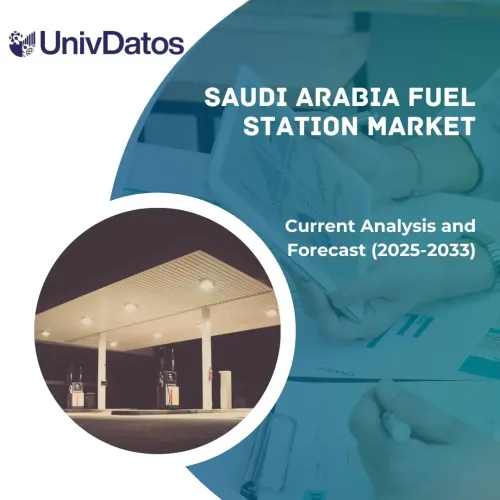에너지 시장의 APAC 디지털 전환: 현재 분석 및 예측 (2024-2032F)
기술 강조 (빅 데이터 분석, 인공 지능, 산업 제어 시스템, 현장 장치, 확장 현실, IoT); 적용 분야 (석유 및 가스, 발전, 유틸리티, 기타); 및 국가
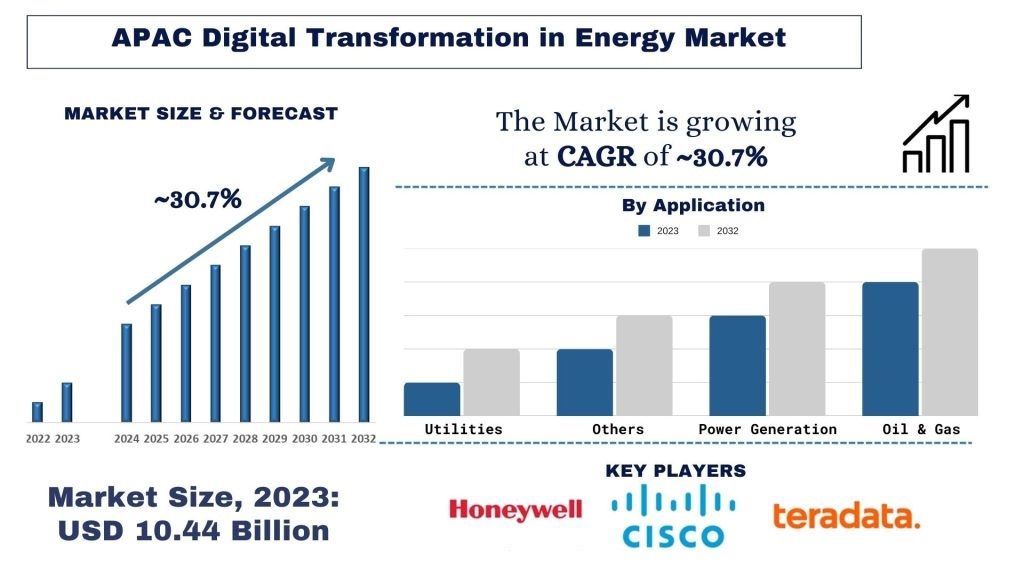
APAC 에너지 시장의 디지털 전환 규모 및 예측
APAC 에너지 시장의 디지털 전환 시장은 2023년에 104억 4천만 달러로 평가되었으며, 예측 기간(2024-2032F) 동안 연평균 성장률(CAGR) 30.7%로 성장할 것으로 예상됩니다.
APAC 에너지 시장의 디지털 전환 분석
APAC은 에너지 시장의 디지털 전환에서 상당한 시장 점유율을 확보했으며 예측 기간 동안 영향력 있는 CAGR을 기록할 것으로 예상됩니다.
APAC 지역에서 가변 재생 에너지는 전력 부문의 탈탄소화에 중추적인 역할을 하고 있습니다. 에너지 시스템의 디지털화는 정책 우선순위이며, 쌍둥이 전환으로서 APAC 그린 딜 및 디지털 10년 정책 프로그램 2030과 연결되어 있습니다.
에너지 시스템 통합을 위한 APAC 위원회의 권고에서 제시된 주요 조치 중 하나는 디지털 솔루션 구현을 가속화하기 위해 간소화된 에너지 디지털화 실행 계획을 배포하는 것입니다. 이는 이해 관계자 간의 원활하고 상호 운용 가능한 데이터 기반 상호 작용을 활용하여 에너지 시스템을 더 잘 통합하는 데 도움이 될 것입니다. 권고에 따라 2022년 11월 Enershare 프로젝트는 최초의 APAC 공통 에너지 데이터 공간 개발을 위해 8백만 유로를 받았습니다.
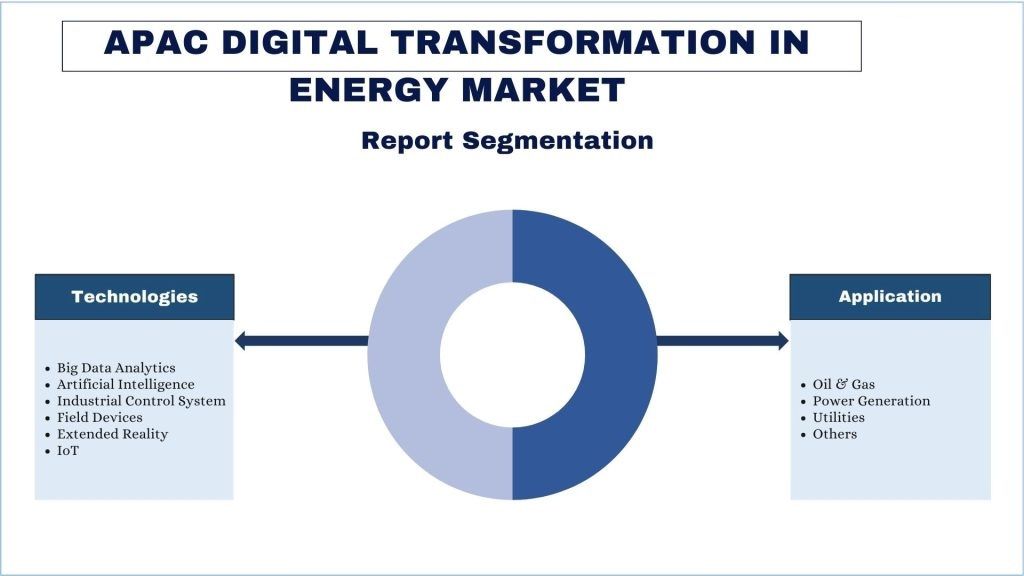
APAC 에너지 시장의 디지털 전환 동향
이 섹션에서는 연구 전문가 팀이 확인한 에너지 시장의 APAC 디지털 전환의 다양한 세그먼트에 영향을 미치는 주요 시장 동향에 대해 논의합니다.
에너지 산업의 디지털 전환에서 빅 데이터 분석
빅 데이터 분석은 패턴과 추세를 발견하기 위해 대량의 데이터를 수집, 분석 및 해석하는 것을 의미합니다. 에너지 부문의 빅 데이터는 운영 효율성 향상, 비용 절감, 고객 만족도 향상, 에너지 생산 최적화 등 다양한 이점을 가져올 수 있습니다. 전력 유틸리티를 위한 빅 데이터 분석 통합은 전기가 그리드에서 배포되고 관리되는 방식을 혁신했습니다. 스마트 미터 및 기타 센서의 데이터를 분석함으로써 유틸리티는 정전, 용량 제약 및 에너지 도난과 같은 문제를 식별하고 해결하여 그리드의 실시간 기능에 대한 귀중한 통찰력을 얻을 수 있습니다. 스마트 그리드 관리는 그리드의 전반적인 효율성을 향상시킬 뿐만 아니라 전원 공급의 신뢰성과 복원력을 향상시킵니다.
인도는 예측 기간 동안 상당한 CAGR로 성장할 것으로 예상됩니다.
2021년 글래스고 정상 회담에서 인도는 비화석 연료 용량을 2030년까지 500GW 이상으로 늘리고 국가 전력 수요의 50%를 재생 에너지로 충당할 것이라고 발표했습니다. 인도의 많은 에너지 회사는 계획된 용량에 도달하기 위해 디지털화를 구현하기 시작했습니다. 예를 들어, 전력부 산하의 마하라트나 공공 부문 기업(PSU)인 REC(이전 Rural Electrification Corporation Limited)는 국립 정보 센터 서비스 Inc.(NICSI)와 양해 각서(MoU)를 체결했습니다. 그들은 다양한 정보 통신 기술(ICT) 및 디지털 전환 서비스에 협력할 것입니다. MoU는 IoT, 인공 지능(AI), 머신 러닝, 데이터 분석, 블록체인 및 사이버 보안과 같은 최첨단 기술 탐색을 가능하게 함으로써 REC 생태계를 강화할 것으로 예상됩니다.
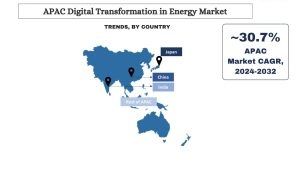
APAC 에너지 산업 개요의 디지털 전환
에너지 시장의 APAC 디지털 전환은 여러 글로벌 및 국제 시장 참여자의 존재로 인해 경쟁이 치열하고 파편화되어 있습니다. 주요 업체는 파트너십, 계약, 협력, 신제품 출시, 지리적 확장, 인수 합병 등 시장 입지를 강화하기 위해 다양한 성장 전략을 채택하고 있습니다. 시장에서 활동하는 주요 업체로는 Schneider Electric SE, Honeywell International Inc., Rockwell Automation Inc., SAP, ABB, IBM Corporation, Microsoft, Cisco Systems Inc., Teradata, Intel Corporation 등이 있습니다.
APAC 에너지 시장 뉴스에서 디지털 전환
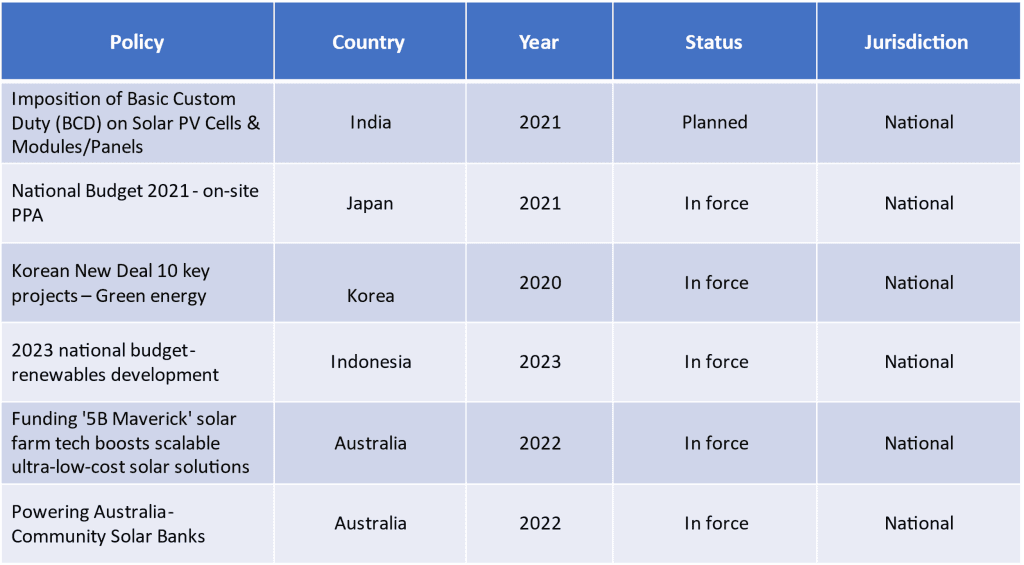
APAC 에너지 시장 보고서 범위의 디지털 전환
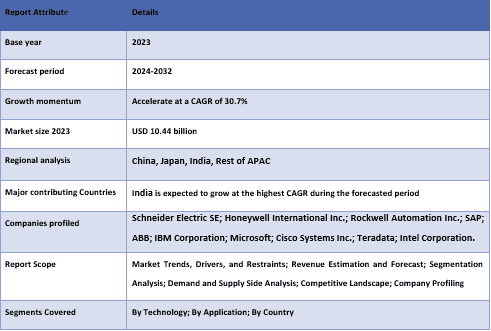
이 보고서를 구매해야 하는 이유:
- 이 연구에는 인증된 주요 산업 전문가가 검증한 시장 규모 측정 및 예측 분석이 포함되어 있습니다.
- 이 보고서는 전체 산업 성과에 대한 빠른 검토를 한눈에 제공합니다.
- 이 보고서는 주요 비즈니스 재무, 제품 포트폴리오, 확장 전략 및 최근 개발에 중점을 두고 주요 산업 동료에 대한 심층 분석을 다룹니다.
- 산업에서 널리 퍼져 있는 동인, 제약, 주요 동향 및 기회에 대한 자세한 조사.
- 이 연구는 다양한 세그먼트에 걸쳐 시장을 포괄적으로 다룹니다.
- 산업에 대한 심층적인 지역 수준 분석.
맞춤화 옵션:
에너지 시장의 APAC 디지털 전환은 요구 사항 또는 기타 시장 세그먼트에 따라 추가로 사용자 정의할 수 있습니다. 이 외에도 UMI는 귀하가 귀하만의 비즈니스 요구 사항이 있을 수 있음을 이해하므로 귀하의 요구 사항에 완벽하게 맞는 보고서를 얻으려면 언제든지 저희에게 문의하십시오.
목차
APAC 에너지 시장의 디지털 전환 분석을 위한 연구 방법론 (2024-2032)
APAC 에너지 시장의 디지털 전환의 과거 시장 분석, 현재 시장 추정, 미래 시장 예측은 APAC 주요 지역에서 에너지 시장의 디지털 전환 도입을 생성하고 분석하기 위해 수행된 세 가지 주요 단계였습니다. 과거 시장 수치를 수집하고 현재 시장 규모를 추정하기 위해 광범위한 2차 연구가 수행되었습니다. 둘째, 이러한 통찰력을 검증하기 위해 수많은 조사 결과와 가정이 고려되었습니다. 또한 APAC 에너지 시장의 디지털 전환 가치 사슬 전반에 걸쳐 업계 전문가와 광범위한 1차 인터뷰도 진행되었습니다. 1차 인터뷰를 통해 시장 수치를 가정하고 검증한 후, 전체 시장 규모를 예측하기 위해 하향식/상향식 접근 방식을 사용했습니다. 이후, 산업에 관련된 세분 시장과 하위 세분 시장의 시장 규모를 추정하고 분석하기 위해 시장 세분화 및 데이터 삼각 측량 방법이 채택되었습니다. 자세한 방법론은 아래에 설명되어 있습니다.
과거 시장 규모 분석
1단계: 2차 출처에 대한 심층 연구:
연간 보고서 및 재무 제표, 실적 발표, 보도 자료 등 회사 내부 소스와 저널, 뉴스 및 기사, 정부 간행물, 경쟁사 간행물, 부문 보고서, 타사 데이터베이스 및 기타 신뢰할 수 있는 간행물을 포함한 외부 소스를 통해 APAC 에너지 시장의 디지털 전환의 과거 시장 규모를 얻기 위해 자세한 2차 연구가 수행되었습니다.
2단계: 시장 세분화:
APAC 에너지 시장의 디지털 전환의 과거 시장 규모를 확보한 후, 주요 지역의 다양한 세분 시장 및 하위 세분 시장에 대한 과거 시장 통찰력과 점유율을 수집하기 위해 자세한 2차 분석을 수행했습니다. 주요 세분 시장은 기술 및 애플리케이션으로 보고서에 포함되어 있습니다. 해당 지역에서 테스트 모델의 전반적인 채택을 평가하기 위해 추가 국가 수준 분석이 수행되었습니다.
3단계: 요인 분석:
다양한 세분 시장 및 하위 세분 시장의 과거 시장 규모를 확보한 후, APAC 에너지 시장의 디지털 전환의 현재 시장 규모를 추정하기 위해 자세한 요인 분석을 수행했습니다. 또한 APAC 에너지 시장의 디지털 전환의 기술 및 애플리케이션과 같은 종속 변수와 독립 변수를 사용하여 요인 분석을 수행했습니다. 전 세계 APAC 에너지 시장의 디지털 전환 부문에서 최고의 파트너십, 인수 합병, 사업 확장 및 제품 출시를 고려하여 수요 및 공급 측면 시나리오에 대한 철저한 분석이 수행되었습니다.
현재 시장 규모 추정 및 예측
현재 시장 규모 측정: 위의 3단계의 실행 가능한 통찰력을 바탕으로 APAC 에너지 시장의 디지털 전환의 현재 시장 규모, 주요 업체 및 세분 시장의 시장 점유율에 도달했습니다. 필요한 모든 백분율 점유율 분할 및 시장 세분화는 위에서 언급한 2차 접근 방식을 사용하여 결정되었으며 1차 인터뷰를 통해 검증되었습니다.
추정 및 예측: 시장 추정 및 예측을 위해 이해 관계자에게 제공되는 동인 및 추세, 제약 및 기회를 포함한 다양한 요인에 가중치가 할당되었습니다. 이러한 요인을 분석한 후 관련 예측 기술, 즉 하향식/상향식 접근 방식을 적용하여 전 세계 주요 시장에서 다양한 세분 시장 및 하위 세분 시장에 대한 2030년 시장 예측에 도달했습니다. 시장 규모를 추정하기 위해 채택된 연구 방법론은 다음을 포함합니다.
- 주요 시장 전반에 걸쳐 수익(USD) 측면에서 업계의 시장 규모와 APAC 에너지 시장의 디지털 전환의 채택률
- 시장 세분 시장 및 하위 세분 시장의 모든 백분율 점유율, 분할 및 세분화
- 제공되는 제품 측면에서 APAC 에너지 시장의 디지털 전환의 주요 업체. 또한 빠르게 성장하는 시장에서 경쟁하기 위해 이러한 업체가 채택한 성장 전략
시장 규모 및 점유율 검증
1차 연구: 주요 지역 전반에 걸쳐 최고 경영진(CXO/VP, 영업 책임자, 마케팅 책임자, 운영 책임자, 지역 책임자, 국가 책임자 등)을 포함한 핵심 여론 주도층(KOL)과의 심층 인터뷰가 진행되었습니다. 그런 다음 1차 연구 결과가 요약되었고 명시된 가설을 입증하기 위해 통계 분석이 수행되었습니다. 1차 연구의 입력은 2차 결과와 통합되어 정보를 실행 가능한 통찰력으로 전환했습니다.
다양한 지역의 1차 참가자 분할
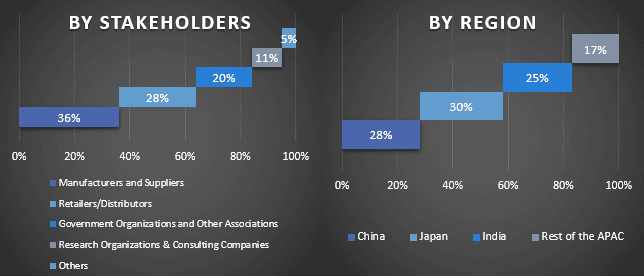
시장 엔지니어링
데이터 삼각 측량 기술은 전체 시장 추정을 완료하고 APAC 에너지 시장의 디지털 전환의 각 세분 시장 및 하위 세분 시장에 대한 정확한 통계 수치에 도달하기 위해 사용되었습니다. APAC 에너지 시장의 디지털 전환의 기술 및 애플리케이션 분야의 다양한 매개변수 및 추세를 연구한 후 데이터를 여러 세분 시장 및 하위 세분 시장으로 분할했습니다.
APAC 에너지 시장의 디지털 전환 연구의 주요 목표
APAC 에너지 시장의 디지털 전환의 현재 및 미래 시장 동향은 연구에서 정확히 지적되었습니다. 투자자는 연구에서 수행된 질적 및 양적 분석에 대한 재량권을 투자에 적용하기 위한 전략적 통찰력을 얻을 수 있습니다. 현재 및 미래 시장 동향은 지역 수준에서 시장의 전반적인 매력을 결정하여 산업 참가자가 미개척 시장을 활용하여 최초 진출자 이점을 활용할 수 있는 플랫폼을 제공합니다. 연구의 다른 양적 목표는 다음과 같습니다.
- 가치(USD) 측면에서 APAC 에너지 시장의 디지털 전환의 현재 및 예측 시장 규모를 분석합니다. 또한 다양한 세분 시장 및 하위 세분 시장의 현재 및 예측 시장 규모를 분석합니다.
- 연구의 세분 시장에는 기술 및 애플리케이션 영역이 포함됩니다.
- APAC 에너지 시장의 디지털 전환에 대한 규제 프레임워크를 정의하고 분석합니다.
- 다양한 중개자의 존재와 관련된 가치 사슬을 분석하고 업계의 고객 및 경쟁업체 행동을 분석합니다.
- 주요 지역에 대한 APAC 에너지 시장의 디지털 전환의 현재 및 예측 시장 규모를 분석합니다.
- 보고서에서 연구된 지역의 주요 국가에는 아시아 태평양이 포함됩니다.
- APAC 에너지 시장의 디지털 전환의 회사 프로필과 빠르게 성장하는 시장에서 지속하기 위해 시장 플레이어가 채택한 성장 전략.
- 업계에 대한 심층적인 지역 수준 분석
자주 묻는 질문 자주 묻는 질문
Q1: APAC 에너지 시장의 디지털 전환에 대한 현재 시장 규모와 성장 잠재력은 무엇입니까?
Q2: APAC 에너지 시장의 디지털 전환 성장을 이끄는 요인은 무엇입니까?
Q3: 애플리케이션별 APAC 에너지 시장의 디지털 전환에서 가장 큰 비중을 차지하는 부문은 무엇입니까?
Q4: APAC 에너지 시장의 디지털 전환에서 떠오르는 기술 및 트렌드는 무엇입니까?
Q5: 에너지 시장에서 어느 지역이 APAC 디지털 전환을 주도할 것인가?
관련 보고서
이 상품을 구매한 고객님들도 함께 구매하신 상품




